JENN-AIR JER8785QAB, JER8785QAF, JER8785QAN, JER8785QAS, JER8885QAB Owner's Manual
...
JENN-AIR ELECTRIC RANGE
ELECTRONIC TOUCH CONTROL 800
USE & CARE
GUIDE
TABLE OF CONTENTS |
|
Important Safety Instructions ..................................... |
1-4 |
Surface Cooking .............................................................. |
5-8 |
Oven Cooking................................................................ |
9-22 |
Care & Cleaning ......................................................... |
23-26 |
Maintenance ................................................................ |
27-28 |
Troubleshooting ......................................................... |
29-30 |
Warranty & Service ........................................................... |
31 |
Guide de l’utilisation et entretien ................................ |
32 |
Guía de Uso y Cuidado ................................................... |
64 |
Form No. A/05/06 |
Part No. 8113P625-60 |
©2006 Maytag Appliances Sales Co. |
All rights reserved. |
Litho U.S.A . |

Installer: Please leave this manual with this appliance.
Consumer: Please read and keep this manual for future reference. Keep sales receipt and/or cancelled check as proof of purchase.
Model Number __________________________________
Serial Number __________________________________
Date of Purchase ________________________________
If you have questions, call: Jenn-Air Customer Assistance 1-800-JENNAIR (1-800-536-6247)
1-800-688-2080 ( U.S. TTY for hearing or speech impaired) (Mon.-Fri., 8 am-8 pm Eastern Time)
Internet: http://www.jennair.com
In our continuing effort to improve the quality and performance of our cooking products, it may be necessary to make changes to the appliance without revising this guide.
For service information, see page 31.
IMPORTANT SAFETY
INSTRUCTIONS
Warning and Important Safety Instructions appearing in this guide are not meant to cover all possible conditions and situations that may occur. Common sense, caution, and care must be exercised when installing, maintaining, or operating the appliance.
Always contact your dealer, distributor, service agent, or manufacturer about problems or conditions you do not understand.
Recognize Safety Symbols, Words, Labels
 WARNING
WARNING
WARNING – Hazards or unsafe practices which COULD result in severe personal injury or death.
 CAUTION
CAUTION
CAUTION – Hazards or unsafe practices which COULD result in minor personal injury.
Read and follow all instructions before using this appliance to prevent the potential risk of fire, electric shock, personal injury or damage to the appliance as a result of improper usage of the appliance. Use appliance only for its intended purpose as described in this guide.
To ensure proper and safe operation: Appliance must be properly installed and grounded by a qualified technician. Do not attempt to adjust, repair, service, or replace any part of your appliance unless it is specifically recommended in this guide. All other servicing should be referred to a qualified servicer.
Always disconnect power to appliance before servicing.
General Instructions
 WARNING
WARNING
• ALL RANGES CAN TIP AND CAUSE INJURIES TO PERSONS
•INSTALL ANTI-TIP DEVICE PACKED WITH RANGE
•FOLLOW ALL INSTALLATION
INSTRUCTIONS
WARNING: To reduce risk of tipping of the appliance from
abnormal usage or by excessive loading of the oven door, the appliance must be secured by a properly installed anti-tip device.
To check if device is properly installed, look underneath range with a flashlight to make sure one of the rear leveling legs is properly engaged in the bracket slot. The anti-tip device secures the rear leveling leg to the floor when properly engaged. You should check this anytime the range has been moved.
To Prevent Fire or Smoke Damage
Be sure all packing materials are removed from the appliance before operating it.
Keep area around appliance clear and free from combustible materials. Flammable materials should not be stored in an oven.
Many plastics are vulnerable to heat. Keep plastics away from parts of the appliance that may become warm or hot.
To prevent grease fires, do not let cooking grease or other flammable materials accumulate in or near the appliance.
1

IMPORTANT SAFETY INSTRUCTIONS
In Case of Fire
Turn off appliance and ventilating hood to avoid spreading the flame. Extinguish flame then turn on hood to remove smoke and odor.
•Cooktop: Smother fire or flame in a pan with a lid or cookie sheet.
NEVER pick up or move a flaming pan.
•Oven: Smother fire or flame by closing the oven door.
Do not use water on grease fires. Use baking soda, a dry chemical or foam-type extinguisher to smother fire or flame.
Child Safety
 CAUTION
CAUTION
NEVER store items of interest to children in cabinets above an appliance or on backguard of a range. Children climbing on the appliance door to reach items could be seriously injured.
NEVER leave children alone or unsupervised near the appliance when it is in use or is still hot. Children should never be allowed to sit or stand on any part of the appliance as they could be injured or burned.
Children must be taught that the appliance and utensils in it can be hot. Let hot utensils cool in a safe place, out of reach of small children. Children should be taught that an appliance is not a toy. Children should not be allowed to play with controls or other parts of the appliance.
About Your Appliance
 WARNING
WARNING
NEVER use appliance as a step to reach cabinets above. Misuse of appliance door, such as stepping, leaning or sitting on the door, may result in possible tipping of the appliance, breakage of the door and serious injuries.
To prevent potential hazard to the user and damage to the appliance, do not use appliance as a space heater to heat or warm a room. Also, do not use the oven as a storage area for food or cooking utensils.
Do not obstruct the flow of air by blocking the oven vent.
DO NOT TOUCH HEATING ELEMENTS OR INTERIOR SURFACES OF OVEN. Heating elements may be hot even though they are dark in color. Interior surfaces of any oven become hot enough to cause burns. During and after use, do not touch, or let clothing or other flammable materials contact heating elements or interior surfaces of oven until they have had sufficient time to cool. Other surfaces of the appliance may become hot enough to cause burns – among these surfaces are: oven vent opening and surface near this opening, oven door, window of oven door.
Do not touch a hot oven light bulb with a damp cloth as the bulb could break. Should the bulb break, disconnect power to the appliance before removing bulb to avoid electrical shock.
NEVER use aluminum foil to cover an oven rack or oven bottom. Misuse could result in risk of electric shock, fire, or damage to the appliance. Use foil only as directed in this guide.
Cooking Safety
Never heat an unopened food container in the oven. Pressure build-up may cause container to burst resulting in serious personal injury or damage to the appliance.
Use dry, sturdy potholders. Damp potholders may cause burns from steam. Dish towels or other substitutes should never be used as potholders because they can trail across hot elements and ignite or get caught on appliance parts.
Wear proper apparel. Loose fitting or long hangingsleeved apparel should not be worn while cooking. Clothing may ignite and cause burns if garment comes in contact with heating elements.
Always place oven racks in the desired positions while oven is cool. Slide oven rack out to add or remove food, using dry, sturdy potholders. Always avoid reaching into the oven to add or remove food. If a rack must be moved while hot, use a dry potholder. Do not let potholder contact hot element in oven.
Use racks only in the oven in which they were shipped/ purchased.
2

IMPORTANT SAFETY INSTRUCTIONS
Use care when opening the oven door. Let hot air or steam escape before removing or replacing food.
PREPARED FOOD WARNING: Follow food manufacturer’s instructions. If a plastic frozen food container and/or its cover distorts, warps, or is otherwise damaged during cooking, immediately discard the food and its container. The food could be contaminated.
Do not allow aluminum foil or meat probe to contact heating element.
Always turn off all controls when cooking is completed.
GLASS-CERAMIC SURFACE: NEVER cook on broken cooktop. If cooktop should break, cleaning solutions and spillovers may penetrate the broken cooktop and create a risk of electric shock. Contact a qualified technician immediately.
Deep Fat Fryers
Use extreme caution when moving the grease pan or disposing of hot grease. Allow grease to cool before attempting to move pan.
Utensil Safety
Follow the manufacturer’s directions when using oven cooking bags.
This appliance has been tested for safe performance using conventional cookware. Do not use any devices or accessories that are not specifically recommended in this guide. Do not use add-on oven convection systems. The use of devices or accessories that are not expressly recommended in this guide can create serious safety hazards, result in performance problems, and reduce the life of the components of the appliance.
If pan is smaller than element, a portion of the element will be exposed to direct contact and could ignite clothing or potholder.
Only certain types of glass, glass/ceramic, ceramic, earthenware, or other glazed utensils are suitable for cooktop or oven service without breaking due to the sudden change in temperature. Follow utensil manufacturer’s instructions when using glass.
Turn pan handle toward center of cooktop, not out into the room or over another surface element. This reduces the risk of burns, ignition of flammable materials, or spillage if pan is accidently bumped or reached by small children.
Cooktop
NEVER leave surface units unattended especially when using high heat. An unattended boilover could cause smoking and a greasy spillover can cause a fire.
This appliance is equipped with different size surface elements. Select pans with flat bottoms large enough to cover element. Fitting pan size to element will improve cooking efficiency.
Ventilating Hoods
Clean range hood and filters frequently to prevent grease or other flammable materials from accumulating on hood or filter and to avoid grease fires.
When flaming foods under the hood, turn the fan on.
Cleaning Safety
Clean cooktop with caution. Turn off all controls and wait for appliance parts to cool before touching or cleaning. Clean with caution. Use care to avoid steam burns if a wet sponge or cloth is used to wipe spills on a hot surface. Some cleaners can produce noxious fumes if applied to a hot surface.
Clean only parts listed in this guide.
Self-Clean Oven
 CAUTION
CAUTION
Do not leave racks, broiling pan, food or cooking utensils, etc. in the oven during the self-clean cycle.
Do not clean door gasket. The door gasket is essential for a good seal. Care should be taken not to rub, damage, or move the gasket.
Do not use oven cleaners or oven liners of any kind in or around any part of the self-clean oven.
Before self-cleaning the oven, remove broiler pan, oven racks and other utensils, and wipe off excessive spillovers to prevent excessive smoke or flare ups.
3

IMPORTANT SAFETY INSTRUCTIONS
Important Safety Notice and Warning
The California Safe Drinking Water and Toxic Enforcement Act of 1986 (Proposition 65) requires the Governor of California to publish a list of substances known to the State of California to cause cancer or reproductive harm, and requires businesses to warn customers of potential exposures to such substances.
Users of this appliance are hereby warned that when the oven is engaged in the self-clean cycle, there may be some low-level exposure to some of the listed substances, including carbon monoxide. Exposure to
these substances can be minimized by properly venting the oven to the outdoors by opening the windows and/ or door in the room where the appliance is located during the self-clean cycle.
IMPORTANT NOTICE REGARDING PET BIRDS:
Never keep pet birds in the kitchen or in rooms where the fumes from the kitchen could reach. Birds have a very sensitive respiratory system. Fumes released during an oven self-cleaning cycle may be harmful or fatal to birds. Fumes released due to overheated cooking oil, fat, margarine and overheated non-stick cookware may be equally harmful.
Save These Instructions for Future Reference
4
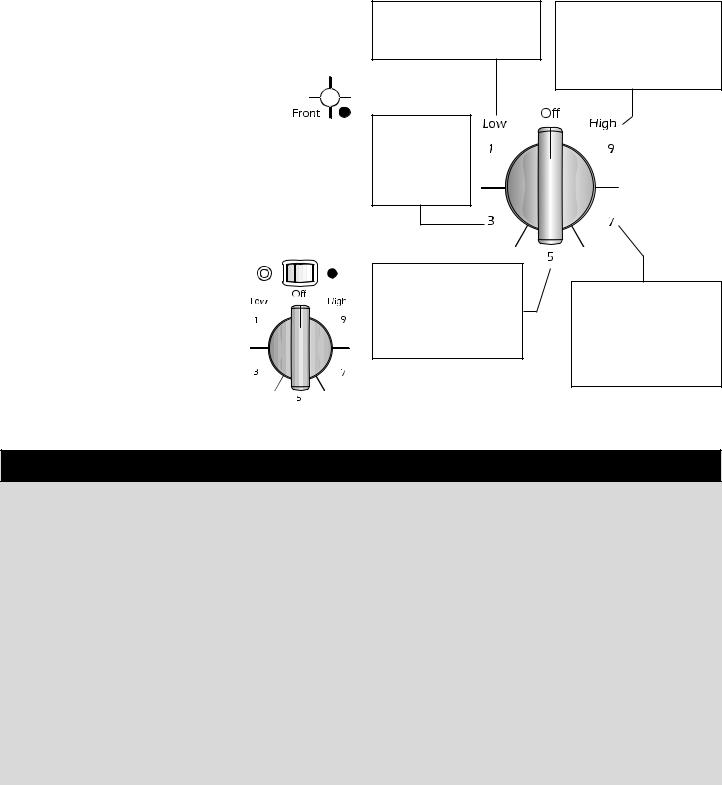
SURFACE COOKING
Surface Controls
Use to turn on the surface elements. An infinite choice of heat settings is available from Low to High. The knobs can be set on or between any of the settings.
Setting the Controls
1.Place pan on surface element.
2.Push in and turn the knob in either direction to the desired heat setting.
• The control panel is marked to identify which
element the knob controls. For example, the graphic at right indicates right front element.
3.There is an element indicator light on the control panel. When any surface control knob is turned on, the light will turn on. The light will turn off when all the surface elements are turned off.
When a control is turned on, a glow can be seen through the smoothtop surface. The element will cycle on and off to maintain the preset heat setting, even on High.
4.After cooking, turn knob to Off.
Remove pan.
Dual Elements
The cooking surface has two dual ele-
ments located in the right front and left front of the smoothtop. This allows you to
change the size of these elements.
Press the switch to the left to use the large
element or to the right to use the small element. The selection should be made before turning on the element.
Suggested Heat Settings
The size, type of cookware and cooking operation will affect the heat setting. For information on cookware and other factors affecting heat settings, refer to Cookware Recommendations on page 7.
Low (1): Use to keep foods warm and melt chocolate and butter.
Med. Low (3): Use to continue cooking covered foods or steam foods.
High (9): Use to bring liquid to a boil. Always reduce setting to a lower heat when liquids begin to boil or foods begin to cook.
Medium (5): Use to maintain slow boil for large amounts of liquids and for most frying operations.
Med. High (7): Use to brown meat, heat oil for deep fat frying or sauteing. Maintain fast boil for large amounts of liquids.
 CAUTION
CAUTION
BEFORE COOKING
•Always place a pan on the surface unit before you turn it on. To prevent damage to range, never operate surface unit without a pan in place.
•NEVER use the cooktop as a storage area for food or cookware.
DURING COOKING
•Be sure you know which knob controls which surface unit. Make sure you turned on the correct surface unit.
•Begin cooking on a higher heat setting then reduce to a lower setting to complete the operation. Never use a high heat setting for extended cooking.
•NEVER allow a pan to boil dry. This could damage the pan and the appliance.
•NEVER touch cooktop until it has cooled. Expect some parts of the cooktop, especially around the surface units, to become warm or hot during cooking. Use potholders to protect hands.
AFTER COOKING
•Make sure surface unit is turned off.
•Clean up messy spills as soon as possible.
OTHER TIPS
•If cabinet storage is provided directly above cooking surface, limit it to items that are infrequently used and can be safely stored in an area subjected to heat. Temperatures may be unsafe for items such as volatile liquids, cleaners or aerosol sprays.
•NEVER leave any items, especially plastic items, on the cooktop. The hot air from the vent may ignite flammable items, melt or soften plastics, or increase pressure in closed containers causing them to burst.
•NEVER allow aluminum foil, meat probes or any other metal object, other than a pan on a surface element, to contact heating elements.
•NEVER store heavy items above the cooktop that could fall and damage it.
5
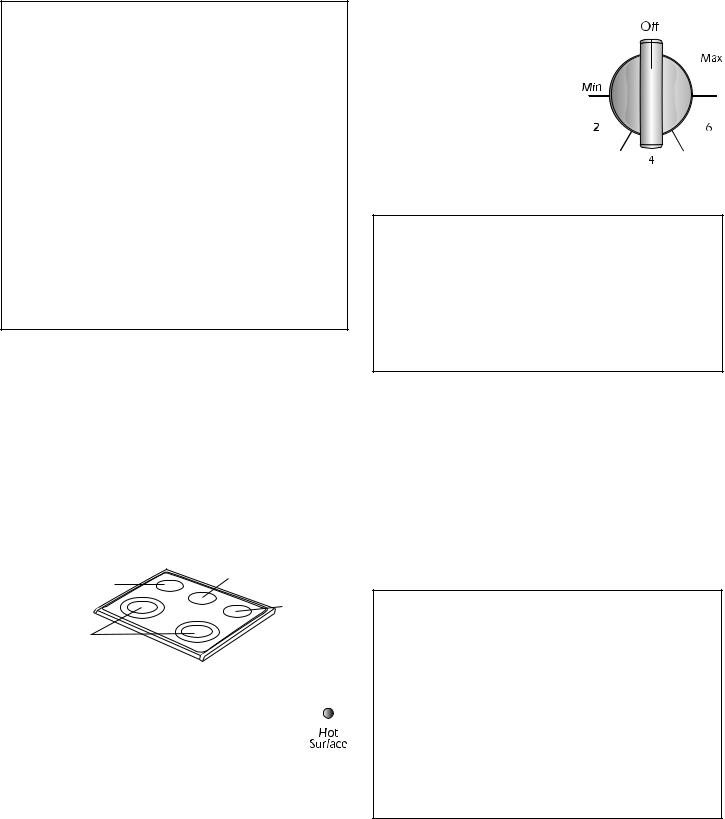
SURFACE COOKING
Smoothtop Surface
Smoothtop Surface Notes:
•Cooktop may emit light smoke and odor the first few times the cooktop is used. This is normal.
•Smoothtop cooktops retain heat for a period of time after the element is turned off. Turn the elements off a few minutes before food is completely cooked and use the retained heat to complete cooking. When the hot surface light turns off, the cooking area will be cool enough to touch. Because of the way they retain heat, the smoothtop elements will not respond to changes in settings as quickly as coil elements.
•In the event of a potential boilover, remove the pan from the cooking surface.
•Never attempt to lift the cooktop.
•The smoothtop surface may appear discolored when it is hot. This is normal and will disappear when the surface cools.
Cooking Areas
The cooking areas on your range are identified by permanent circles on the smoothtop surface. For most efficient cooking, fit the pan size to the element size.
Pans should not extend more than 1/2 to 1-inch beyond the cooking area.
When a control is turned on, a glow can be seen through the smoothtop surface. The element will cycle on and off to maintain the preset heat setting, even on Hi.
For more information on cookware, refer to Cookware Recommendations on page 7.
WARMING CENTER
(SELECT MODELS)
SINGLE
ELEMENT
SINGLE
ELEMENT
DUAL
ELEMENT
Hot Surface Light
The Hot Surface indicator light is located on the control panel. The light will be illuminated when any cooking area is hot. It will remain on, even after the control is turned off, until the area has cooled.
Warming Center (select models)
Use the Warming Center to keep cooked foods warm, such as vegetables, gravies and oven-safe dinner plates.
Setting the Control:
1.Push in and turn the knob. Warming temperatures are approxi-
mate and are indicated on the control as Min, 2, 4, 6 and Max. However, the control can be set to any position between
Min and Max.
2. When done, turn the control to Off and
remove food. The Hot Surface indicator light will go off when the Warming Center surface has cooled.
Notes:
•Never warm food for longer than one hour (eggs for 30 minutes), as food quality may deteriorate.
•Do not heat cold food on the Warming Center.
•Heat settings will vary depending on type and amount of food. Always hold food at proper food temperatures. USDA recommends food temperatures between 140°-170° F.
Suggested Settings
Setting |
|
Type of food |
|
Min - 2 |
Breads/Pastries |
Gravies |
|
|
|
Casseroles |
Eggs |
|
|
|
|
2 |
- 6 |
Meats |
Dinner Plate with Food |
|
|
Soups (Cream) |
Sauces |
|
|
Stews |
Vegetables |
|
|
|
|
6 |
- Max |
Fried Foods |
Hot Beverages |
|
|
Soups (Liquid) |
|
|
|
|
|
Warming Center Notes:
•Use only cookware and dishes recommended as safe for oven and cooktop use.
•Always use oven mitts when removing food from the Warming Center as cookware and plates will be hot.
•All foods should be covered with a lid or aluminum foil to maintain food quality.
•When warming pastries and breads the cover should have an opening to allow moisture to escape.
•Do not use plastic wrap to cover foods. Plastic may melt on to the surface and be very difficult to clean.
6

SURFACE COOKING
Tips to Protect the
Smoothtop Surface
Cleaning (see page 25 for more information)
•Before first use, clean the cooktop.
•Clean your cooktop daily or after each use. This will keep your cooktop looking good and can prevent damage.
•If a spillover occurs while cooking, immediately clean the spill from the cooking area while it is hot to prevent a tough cleaning chore later. Using extreme care, wipe spill with a clean dry towel.
•Do not allow spills to remain on the cooking area or the cooktop trim for a long period of time.
•Never use abrasive cleansing powders or scouring pads which will scratch the cooktop.
•Never use chlorine bleach, ammonia or other cleansers not specifically recommended for use on glass-ceramic.
To Prevent Marks & Scratches
•Do not use glass pans. They may scratch the surface.
•Never place a trivet or wok ring between the surface and pan. These items can mark or etch the top.
•Do not slide aluminum pans across a hot surface. The pans may leave marks which need to be removed promptly. (See Cleaning, page 25.)
•Make sure the surface and the pan bottom are clean before turning on to prevent scratches.
•To prevent scratching or damage to the glass-ceramic top, do not leave sugar, salt or fats on the cooking area. Wipe the cooktop surface with a clean cloth or paper towel before using.
•Never slide heavy metal pans across the surface since these may scratch.
To Prevent Stains
•Never use a soiled dish cloth or sponge to clean the cooktop surface. A film will remain which may cause stains on the cooking surface after the area is heated.
•Continuously cooking on a soiled surface may/will result in a permanent stain.
To Prevent Other Damage
•Do not allow plastic, sugar or foods with high sugar content to melt onto the hot cooktop. Should this happen, clean immediately. (See Cleaning, page 25.)
•Never let a pan boil dry as this will damage the surface and pan.
•Never use cooktop as a work surface or cutting board.
•Never cook food directly on the surface.
•Do not use a small pan on a large element. Not only does this waste energy, but it can also result in spillovers burning onto the cooking area which requires extra cleaning.
•Do not use non-flat specialty items that are oversized or uneven such as round bottom woks, rippled bottom and/or oversized canners and griddles.
•Do not use foil or foil-type containers. Foil may melt onto the glass. If metal melts on the cooktop, do not use. Call an authorized Jenn-Air Servicer.
Cookware Recommendations
Using the right cookware can prevent many problems, such as food taking longer to cook or achieving inconsistent results. Proper pans will reduce cooking times, use less energy, and cook food more evenly.
Flat Pan Tests
See if your pans are flat.
The Ruler Test:
1.Place a ruler across the bottom of the pan.
2.Hold it up to the light.
3.Little or no light should be visible under the ruler.
The Bubble Test:
1.Put 1 inch of water in the pan. Place on cooktop and turn control to High.
2.Watch the formation of the bubbles as the water heats. Uniform bubbles mean good performance, and uneven bubbles indicate hot spots and uneven cooking.
Select |
Avoid |
Flat, smooth-bottom |
Pans with grooved or warped bottoms. |
pans. |
Pans with uneven bottoms do not cook |
|
efficiently and sometimes may not |
|
boil liquid. |
|
|
Heavy-gauge pans. |
Very thin-gauge metal or glass pans. |
|
|
Pans that are the |
Pans smaller or larger than the |
same size as the |
element by 1 inch. |
element. |
|
|
|
Secure handles. |
Cookware with loose or broken handles. |
|
Heavy handles that tilt the pan. |
Tight-fitting lids. |
Loose-fitting lids. |
|
|
Flat bottom woks. |
Woks with a ring-stand bottom. |
|
|
7
SURFACE COOKING
Canning and Oversize Cookware
All canners and large pots must have flat bottoms and must be made from heavy-gauge materials. This is critical on smoothtop surfaces. The base must not be more than
1 inch larger than the element.
When canners and pots do not meet these standards, cooking times may be longer, and cooktops may be damaged.
Some canners are designed with smaller bases for use on smoothtop surfaces.
When canning, use the High heat setting only until the water comes to a boil or pressure is reached in the canner. Reduce to the lowest heat setting that maintains the boil or pressure. If the heat is not turned down, the cooktop may be damaged.
8
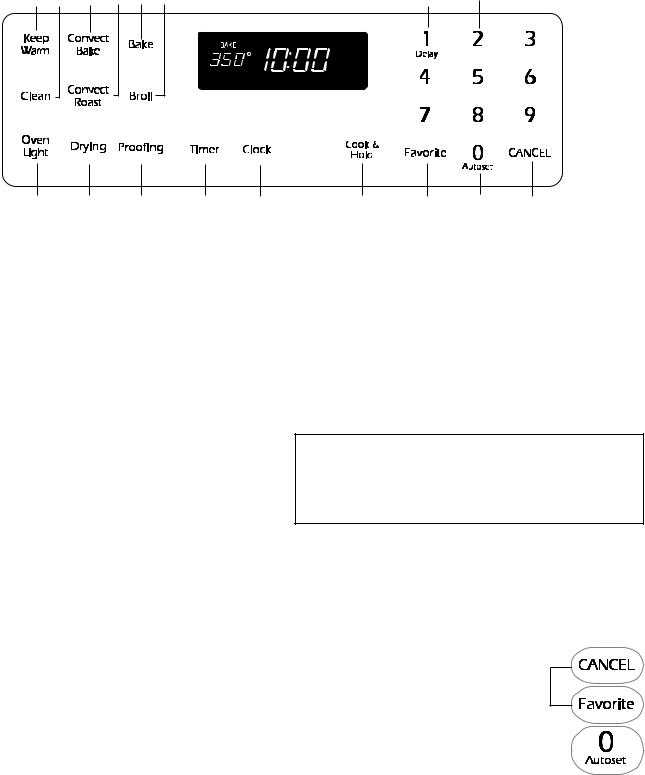
OVEN COOKING
Control Panel
A B C D E F G H
I J K L M N O P Q
The control panel is designed for ease in programming. The display window on the control shows time of day, timer and oven functions. Control panel shown includes Convect and other model specific features. (Styling may vary depending on model.)
A |
Keep Warm |
Use to keep cooked food warm in oven. |
B |
Clean |
Use to set self-clean cycle. |
C |
Convect Bake |
Use for convection baking. |
|
(select models) |
|
D |
Convect Roast |
Use for convection roasting. |
|
(select models) |
|
E |
Bake |
Use for baking and roasting. |
F |
Broil |
Use for broiling and top browning. |
G |
Delay |
Programs the oven to start baking or |
|
|
cleaning at a later time. |
H |
Number Pads |
Use to set time and temperature. |
I |
Oven Light |
Use to turn the oven light on or off. |
J |
Drying |
Use for drying fruits, vegetables, herbs, |
|
(select models) |
etc. |
K |
Proofing |
Use to raise yeast-based bread products |
|
(select models) |
before baking. |
L |
Timer |
Sets the timer. |
M |
Clock |
Use to set time-of-day clock. |
N |
Cook & Hold |
Bakes for a preset time, then holds food |
|
|
warm for 1 hour. |
O |
Favorite |
Use to set and save a specific Cook |
|
|
& Hold procedure. |
P |
Autoset |
Use to quickly set temperature. |
Q |
CANCEL |
Cancels all operations except Timer and |
|
|
Clock. |
|
|
|
Using the Touchpads
•Press the desired pad.
•Press the number pads to enter time or temperature.
•Press the Autoset 0 pad to enter temperature.
•A beep will sound when any pad is touched.
•A double beep will sound if a programming error occurs.
Note: Four seconds after entering the number, the time or temperature will automatically be entered. If more than 30 seconds elapse between touching a function pad and the number pads, the function will be canceled and the display will return to the previous display.
Clock
The clock can be set to display time in a 12-hour or 24-hour format. The clock is set at the factory for the 12-hour format.
To change the clock to 24-hour format:
1. Press and hold the CANCEL and Favorite pads for three seconds.
• 12 Hr flashes in the display.
2. Press the Autoset 0 pad to select 24 Hr; press again to select 12 Hr.
3. Set the time of day following the directions in the To set the Clock section.
9
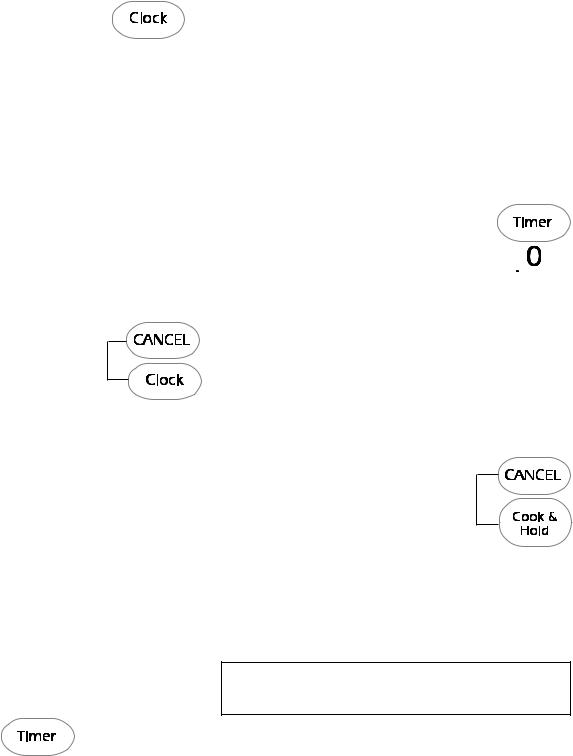
OVEN COOKING
To set the Clock:
1.Press the Clock pad.
•The time of day flashes in the display.
2.Press the appropriate number pads to set the time of day.
•Colon flashes in the display.
3.Press the Clock pad again or wait four seconds.
•The colon will remain on.
When electrical power is supplied or after a power interruption, the last clock time before power was interrupted will flash.
To recall the time of day when another time function is showing, press the Clock pad.
Clock time cannot be changed when the oven has been programmed for Delay cook or clean or Cook & Hold.
To cancel the Clock display:
If you do not want the time of day to display:
Press and hold the CANCEL and Clock pads for three seconds. The time of day will disappear from the display.
When the clock display is canceled, press the
Clock pad to briefly display the time of day.
When the clock display is canceled, after 15 minutes, the oven control will go into Standby Mode to save energy. The display will be blank and the oven light will not operate. To "wake up" the control from Standby Mode, press any touchpad. A double beep will sound.
To restore the Clock display:
Press and hold the CANCEL and Clock pads for three seconds. The time of day will reappear in the display.
Timer
The timer can be set from one minute (0:01) up to 99 hours and 59 minutes (99:59).
The timer can be used independently of any other oven activity. It can also be set while another oven function is operating.
The Timer does not control the oven. It only controls a beeper.
To set the Timer:
1.Press the Timer pad.
•0:00 and TIMER flash in the display.
2.Press the appropriate number pads until the correct time appears in the display.
•The colon and TIMER will continue to flash.
3.Press Timer pad again or wait four seconds.
•The colon stops flashing and the time begins counting down.
•The last minute of the timer countdown will be displayed in seconds.
4.At the end of the set time, one long beep will sound and “End” will be displayed.
5.Press the Timer pad to clear the display.
To cancel the Timer:
1.Press and hold the Timer pad for three seconds. OR
2. Press the Timer pad and press ‘0’ using the number pads.
Locking the Control and Oven Door
The touchpad and oven door can be locked for safety, cleaning, or to prevent unwanted use. The touchpads will not function when locked.
If the oven is currently in use, the touchpads and door cannot be locked.
The current time of day will remain in the display when the touchpads and door are locked.
To lock:
Press and hold the CANCEL and Cook &
Hold pads for three seconds. (Press
CANCEL pad first.)
• OFF appears in the display.
•LOCK flashes while the door is locking.
To unlock:
Press and hold the CANCEL and Cook & Hold pads for three seconds. (Press CANCEL pad first.) OFF disappears from the display.
Note: The touchpads and oven door cannot be locked if the oven temperature is 400° F or above.
Fault Codes
BAKE or LOCK may flash rapidly in the display to alert you if there is an error or a problem. If BAKE or LOCK flash in the display, press the CANCEL pad. If BAKE or LOCK continue to flash, disconnect power to the appliance. Wait a few minutes, and then reconnect power. If the flashing still continues, disconnect power to the appliance and call an authorized servicer.
10
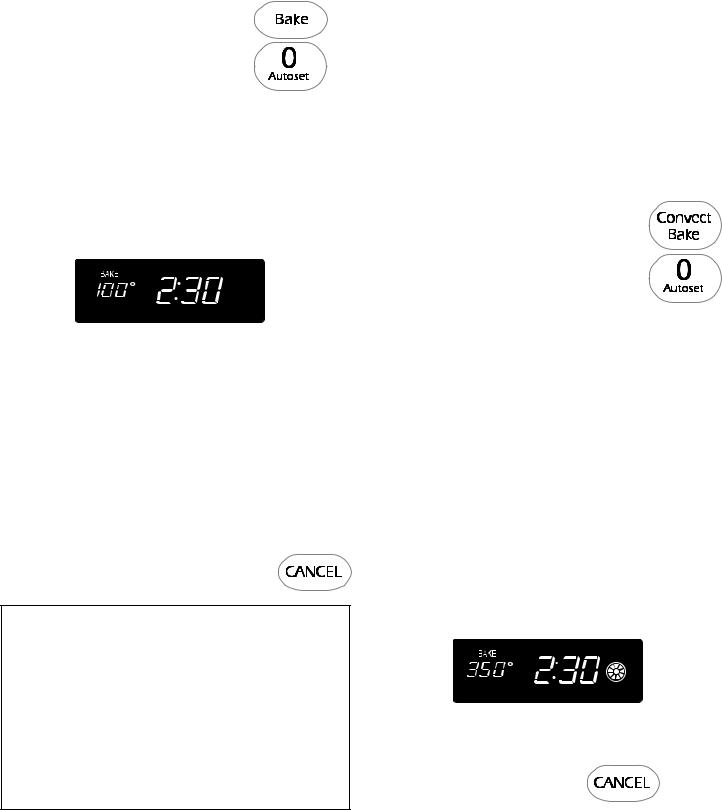
OVEN COOKING
Baking
To set Bake:
1.Press the Bake pad.
•BAKE will flash.
•000 will flash in the display.
2.Select the oven temperature. Press the Autoset 0 pad for 350° F or the appropriate number pads.
•Each additional press of the Autoset 0 pad will increase the temperature by 25°.
•The oven temperature can be set from 170° to 550°.
3.Press Bake pad again or wait four seconds.
•BAKE will stop flashing and light in the display.
•100° or the actual oven temperature if over 100° F will display. It will rise in 5° increments until the preset temperature is reached.
4.Allow the oven to preheat for 8-15 minutes.
•When the set oven temperature is reached, one long beep will sound.
•The set temperature will display.
•To recall set temperature during preheat, press Bake pad.
5.Place food in the oven.
6.Check cooking progress at the minimum cooking time. Cook longer if needed.
7.When cooking is finished, press CANCEL pad.
8.Remove food from the oven.
Baking Notes:
•To change the oven temperature during cooking, press Bake, then press the Autoset 0 pad or appropriate number pads until the desired temperature is displayed.
•To change the oven temperature during preheat, press the Bake pad twice, then press the Autoset 0 pad or appropriate number pads until the desired temperature is displayed.
•If you forget to turn off the oven, it will automatically turn off at the end of 12 hours. If you wish to deactivate this feature, see page 18.
Baking Differences Between Your Old and New Oven
It is normal to notice some baking time differences between a new oven and an old one. See “Adjusting the Oven Temperature” on page 19.
Baking with Convection
(select models)
When convection baking, enter your normal baking temperature. The control will automatically reduce the set oven temperature by 25°. The entered temperature will be displayed.
To set Convect Bake:
1. Press the Convect Bake pad.
• BAKE and the FAN icon will flash
• 000 will flash in the display.
2.Select the oven temperature. Press the Autoset 0 pad for 350° F or the appropriate number pads.
•Each additional press of the Autoset 0 pad will increase the temperature by 25 degrees. The oven temperature can be set from 170° to 550°.
3.Press Convect Bake pad again or wait four seconds.
•BAKE will stop flashing.
•100° or the actual oven temperature if over 100° F will display. It will rise in 5° increments until the preset temperature is reached.
•The FAN icon will start to rotate.
4.Allow the oven to preheat for 8-15 minutes.
•When the set oven temperature is reached, one long beep will sound.
•The set temperature will display.
•To recall the set temperature during preheat, press the Convect Bake pad.
5.Place food in the oven.
6.Check cooking progress at the minimum cooking time. Cook longer if needed.
7. When cooking is finished, press CANCEL pad.
8. Remove food from the oven.
11
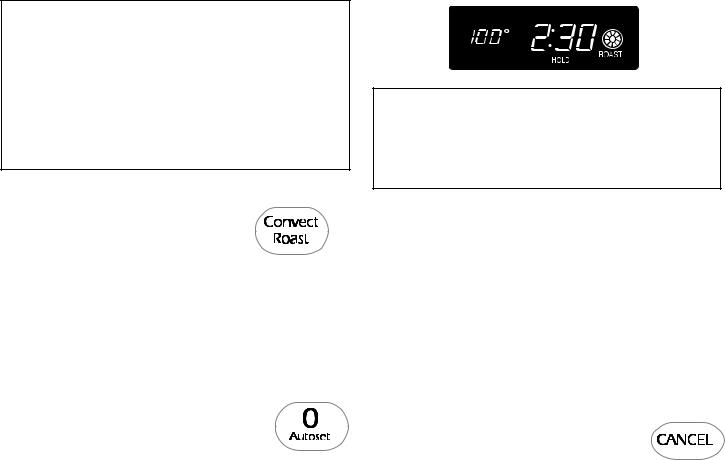
OVEN COOKING
Roasting With Convection
(select models)
When convection roasting, enter your normal roasting time and temperature. The control will automatically prompt you to check the food for doneness at 75% of the set time.
Roasting Notes:
•When convection roasting, the cooking time must be set before setting the temperature.
•If your recipe requires a preheated oven, add 15 minutes to the cooking time programmed.
•Roasting times can vary with different cuts of meat.
•It is not necessary to preheat when convect roasting large cuts of meat.
To set Convect Roast:
1. Press the Convect Roast pad.
• ROAST and the FAN icon will flash.
•00:00 will flash in the display.
•000 lights in the display.
2.Enter the roasting time using the number pads.
•Time can be set from 10 minutes (00:10) to 11 hours, 59 minutes (11:59).
•Press Convect Roast pad again or wait 4 seconds.
•ROAST and the FAN icon flash in the display.
•000 will flash in the display.
3. Select the oven temperature. Press the Autoset 0 pad for 325° F or the appropriate number pads.
•Each additional press of the Autoset 0 pad will increase the temperature by 25°.
•The oven temperature can be set from 170° to 550°.
4.Press Convect Roast pad again or wait four seconds.
•ROAST will stop flashing and light in the display.
•100° or the actual oven temperature will display. It will rise in 5° increments until the preset temperature is reached.
•The FAN icon will start to rotate.
Notes:
•If a preheat is required, allow the oven to preheat for 8-15 minutes.
•When the set oven temperature is reached, one long beep will sound.
5.Place food in the oven.
•Time will start counting down once oven starts heating up.
•To recall the set temperature during preheat, press the Convect Roast pad.
6.When 75% of the set cooking time has elapsed, the oven light will turn on and FOOD will flash in the display. Check the cooking progress at this time. Cook longer if needed.
•The oven light will remain on until the Oven Light pad is pressed.
•Press any pad to recall the cook time remaining.
7.When cooking is finished, press CANCEL pad.
8. Remove food from the oven.
12
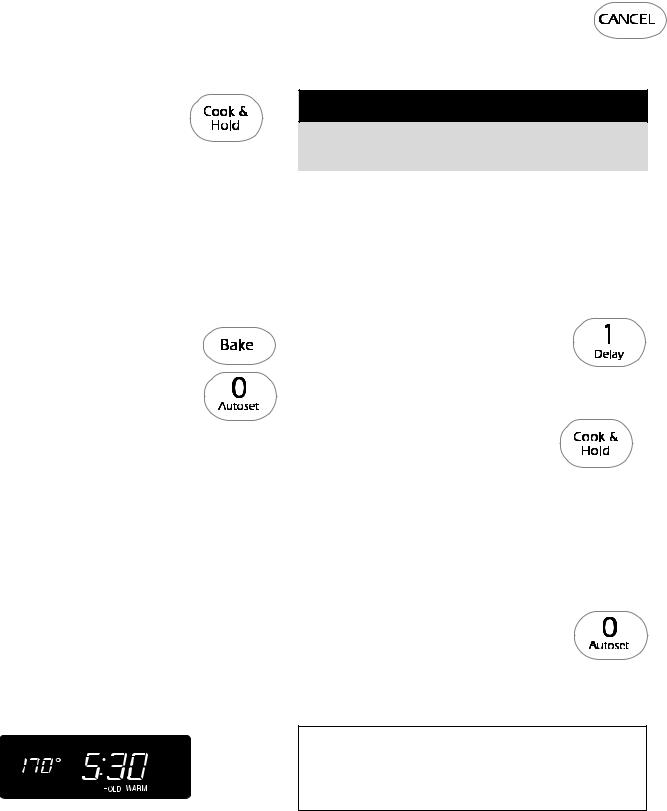
OVEN COOKING
Cook & Hold
When using the Cook & Hold option, the oven begins to heat immediately after the control has been set. Then, the oven cooks for a specified length of time. When that time has elapsed, the oven will keep the food warm for up to an hour then automatically turn off.
To set Cook & Hold:
1.Press the Cook & Hold pad.
•HOLD will flash to indicate that you are in Cook & Hold programming.
•00:00 will flash in the display.
2.Select the amount of time you want to cook by using the number pads.
•HOLD continues to flash.
•The time will light in the display.
•Time can be set from ten minutes (00:10) to 11 hours, 59 minutes (11:59).
3.While HOLD is still flashing, press Bake,
Convect Bake or Convect Roast (select models) and select the oven temperature. Press the Autoset 0 pad for 350° F or the appropriate number pads.
•The desired function word will flash.
•The oven temperature can be set from 170° F to 550° F.
4.Press the desired function pad again OR wait four seconds.
•The desired function word will remain lit.
•The cooking time will show in the display.
•The actual oven temperature will be displayed during preheat.
•The set temperature will display when the oven is preheated.
When the cooking time has elapsed:
•Four beeps will sound.
•HOLD and WARM will light.
•170° will display.
•Time of day will display.
After one hour in HOLD WARM:
•The oven turns off automatically.
•HOLD and WARM go off.
•Remove food from oven.
To cancel Cook & Hold at any time:
Press the CANCEL pad. Remove food from oven.
Delay Cook & Hold
 CAUTION
CAUTION
Do not use delayed baking for highly perishable foods such as dairy products, pork, poultry, or seafood.
When using Delay, the oven begins to cook later in the day. Set the amount of time that you want to delay before the oven turns on and how long you want to cook. The oven begins to heat at the selected time and cooks for the specified length of time.
Delay time can be set from 10 minutes (00:10) to 11 hours, 59 minutes (11:59).
To set a Delayed Cook & Hold cycle:
1.Press the 1 Delay pad.
•DELAY flashes in the display.
•00:00 flashes in the display.
2.Using the appropriate number pads, enter the amount of time you want to delay the start of the Cook & Hold cycle.
3.Press the Cook & Hold pad.
• HOLD and DELAY flash in the display.
•00:00 flashes in the display.
4.Enter the amount of time you want to cook using the number pads.
5.Press Bake, Convect Bake or Convect Roast pad (select models).
6.Set the oven temperature desired by pressing the Autoset 0 pad or the appropriate number pads.
•350° will light when Autoset 0 pad is pressed.
• After four seconds, the entered delay time will appear in the display.
•HOLD turns off.
•BAKE and DELAY remain lit to remind you that
a delayed Cook & Hold cycle has been programmed.
Notes:
•Do not use Delayed Cook & Hold for items that require a preheated oven, such as cakes, cookies, and breads.
•Do not use Delayed Cook & Hold if oven is already hot.
13
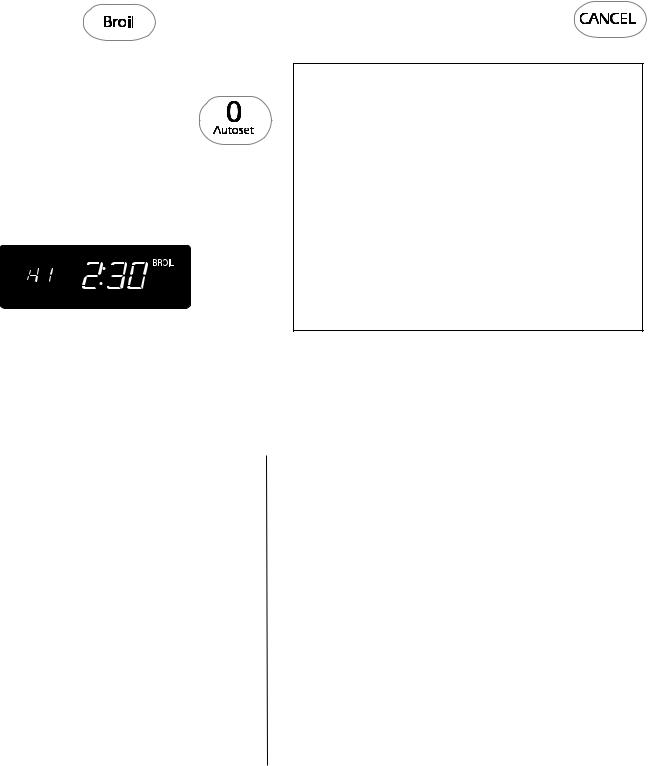
OVEN COOKING
Broiling
To set Broil:
1. Press the Broil pad.
• BROIL and SET flash in the display.
2.Press the Autoset 0 pad once to set HI broil or twice to set LO broil.
• HI or LO will be displayed.
• Select HI broil (550° F) for normal broiling. Select LO broil (450° F) for low-temperature
broiling of longer cooking foods such as poultry.
3.After four seconds, the oven will start.
•BROIL will remain lit.
•HI or LO will remain lit.
4.For optimum browning, preheat broil element for 3-4 minutes before adding food.
5.Place food in the oven. Leave oven door open about four inches (the first stop).
6.Turn meat once about halfway through cooking.
7.When food is cooked, press the CANCEL pad.
Remove food and broiler pan from the oven.
• The time of day will reappear in the display.
Broil Notes:
•For best results when broiling, use a pan designed for broiling.
•Expect broil times to increase and browning to be slightly lighter if appliance is installed on a 208-volt circuit.
•HI is used for most broiling. Use LO broil when broiling longer cooking foods. The lower temperature allows food to cook to the well done stage without excessive browning.
•Broil times may be longer when the lower broiling temperature is selected.
•Most foods should be turned halfway through broiling time.
Broiling Chart
|
|
RACK |
APPROX. TIME |
APPROX. TIME |
|
FOODS |
|
POSITION |
FIRST SIDE |
SECOND SIDE |
|
|
|
|
|
|
|
Beef |
|
|
|
|
|
Steak, 1” thick, |
Medium |
6 |
8 minutes |
7 - 12 minutes |
|
|
Well |
6 |
10 minutes |
8 - 14 minutes |
|
Hamburgers, 3/4” thick, |
Well |
6 or 7 |
9 minutes |
6 |
- 9 minutes |
|
|
|
|
|
|
Pork |
|
|
|
|
|
Bacon |
|
6 |
6 - 10 minutes |
(no turning) |
|
Chops, 1” |
|
6 |
10 - 11 minutes |
12 |
- 14 minutes |
Ham Slice |
|
6 |
5 minutes |
3 |
- 7 minutes |
|
|
|
|
|
|
Poultry |
|
|
LO Broil |
|
LO Broil |
Breast Halves |
|
4 |
15 minutes |
15 |
- 25 minutes |
|
|
|
|
|
|
Seafood |
|
|
|
|
|
Fish Steaks, buttered, 1” thick |
6 |
10 - 15 minutes |
(no turning) |
||
Lobster Tails, 3-4 oz. each |
5 |
7 - 10 minutes |
(no turning) |
||
|
|
|
|
|
|
Note: This chart is a suggested guide. The times may vary with the food being cooked.
14
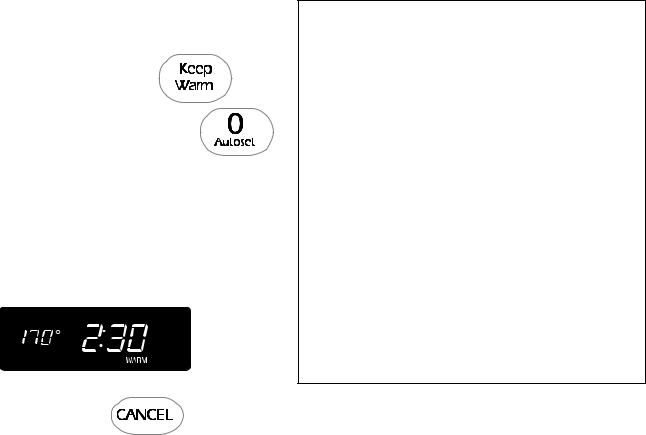
OVEN COOKING
Keep Warm
For safely keeping hot foods warm or for warming breads and plates.
To set Keep Warm:
1. Press the Keep Warm pad.
•WARM flashes in the display.
•000 flashes in the display.
2.Select the Keep Warm temperature. Press the Autoset 0 pad or the appropriate number pads.
•170° will light when the Autoset 0 pad is pressed.
•Each press of the Autoset 0 pad will increase the temperature by 5°.
The Keep Warm temperature can be set from 145° to 190°.
WARM and the temperature will be displayed while the function is active.
To cancel Keep Warm:
1. Press the CANCEL pad.
2. Remove food from the oven.
Keep Warm Notes:
•For optimal food quality, oven cooked foods should be kept warm for no longer than 1 to 2 hours.
•To keep foods from drying, cover loosely with foil or a lid.
•To warm dinner rolls:
-cover rolls loosely with foil and place in oven.
-press Keep Warm and Autoset 0 pads.
-warm for 15-20 minutes.
•To warm plates:
-place 2 stacks of up to four plates each in the oven.
-press Keep Warm and Autoset 0 pads.
-warm for five minutes, turn off the oven and leave plates in the oven for 15 minutes more.
-use only oven-safe plates, check with the manufacturer.
-do not set warm dishes on a cold surface as rapid temperature changes could cause crazing or breakage.
15
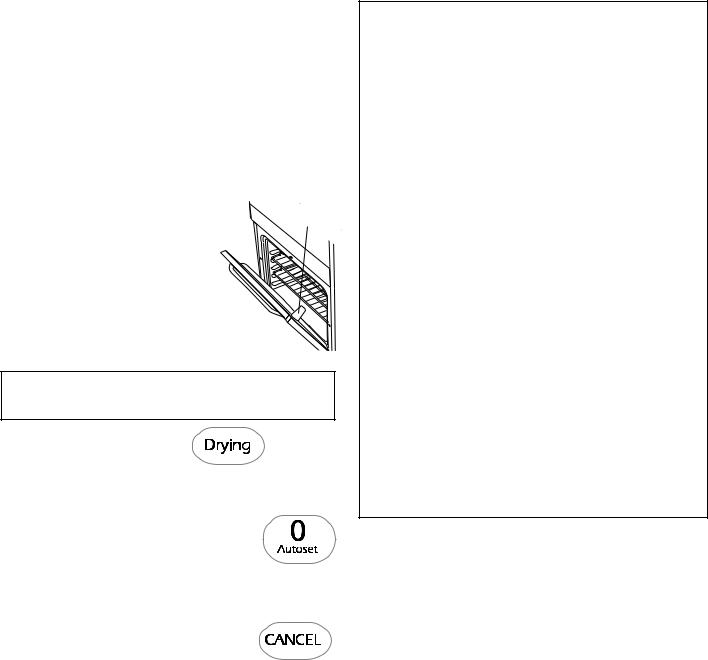
OVEN COOKING
Drying (select models)
For best results, use a drying rack. A drying rack allows air to circulate evenly around the food.
The convection fan will operate during the drying procedure.
To set Drying:
1.Place food in the oven.
•Open the oven door slightly.
The oven door needs to be opened slightly to allow moisture to escape from the oven during the drying process.
• Place the magnetic door spacer (Part No
8010P146-60) on the slightly recessed |
spacer |
|
|
circular area on the upper right of |
|
the oven door. The spacer provides a |
|
gap between the oven frame and the |
|
oven door allowing moisture to escape. |
|
• Gently close the oven door until the spacer rests against the oven frame and light
The oven light will remain OFF when the in the correct location.
Note: If the spacer is not placed correctly, the convection fan will not operate.
2. Press the Drying pad.
•DRY flashes in the display.
3.Press the Autoset 0 pad for 140° F or press the appropriate number pads for the desired drying temperature.
•Pressing the Autoset 0 pad will increase the temperature in 10 degree increments.
•The temperature may be set between 100° - 200° F.
4.After four seconds, DRY and the set temperature will appear in the display.
5.When drying is complete, turn the oven off by pressing the CANCEL pad.
Follow the Drying Guide on page 17 for drying times. Check foods at minimum times given. Cool foods to room temperature before testing for doneness.
Drying Notes:
•To purchase a drying rack, contact your Jenn-Air dealer for the “DRYINGRACK” Accessory Kit or call 1-800-JENNAIR.
•Most fruits and vegetables dry well and retain their color when dried at 140° F. Meat and jerky should be dried at 145° - 150° F. For optimal flavor, dry herbs at 100° F, however, at this lower temperature expect extended drying times of up to 8 hours.
•The length of drying times vary due to the following: Water and sugar content of food, size of food pieces, amount of food being dried, humidity in the air.
•Check foods at the minimum drying time. Dry longer if necessary.
•Fruits that turn brown when exposed to air should be treated with an antioxidant. Try one of the following methods:
1.Dip fruit in a mixture of two parts bottled lemon juice to one part cool water.
2.Soak fruit in a solution of 1 tsp. ascorbic acid or commercial antioxidant to 1 quart of cold water.
•Foods may drip during the drying process. After drying high acid or sugary foods, clean the oven bottom with soap and water. The porcelain oven finish may discolor if acidic or sugary food soils are not wiped up prior to high heat or a self-cleaning cycle.
•More than one rack of food may be dried at the same time. However, additional drying time is needed.
•Refer to other resources at your local library or call your local County Extension service for additional information.
16
OVEN COOKING
Drying Guide (select models)
|
|
|
APPROX. |
|
FRUITS |
VARIETIES BEST |
PREPARATION |
DRY TIME |
TEST FOR DONENESS |
|
FOR DRYING |
|
at 140°F ** |
AT MIN. DRY TIME |
Apples* |
Firm varieties: Graven |
Wash, peel if desired, core and slice |
4-8 hours |
Pliable to crisp. Dried |
|
Stein, Granny Smith, |
into 1/8” slices. |
|
apples store best when they |
|
Jonathan, Winesap, |
|
|
are slightly crisp. |
|
Rome Beauty, Newton. |
|
|
|
|
|
|
|
|
Apricots* |
Blenheim/Royal most |
Wash, halve, and remove pits. |
18-24 hours |
Soft, pliable. |
|
common. Tilton also good. |
|
|
|
|
|
|
|
|
Bananas* |
Firm varieties |
Peel and cut into 1/4” slices. |
17-24 hours. |
Pliable to crisp. |
|
|
|
|
|
Cherries |
Lambert, Royal Ann, |
Wash and remove stems. Halve and |
18-24 hours. |
Pliable and leathery. |
|
Napoleon, Van or Bing. |
remove pits. |
|
|
|
|
|
|
|
Nectarines |
Freestone varieties. |
Halve and remove pits. Peeling |
24-36 hours |
Pliable and leathery. |
and Peaches* |
|
is optional but results in |
|
|
|
|
better-looking dried fruit. |
|
|
|
|
|
|
|
Pears* |
Bartlett |
Peel, halve and core. |
24-36 hours |
Soft and pliable. |
|
|
|
|
|
Pineapple |
Fresh or canned. |
Wash, peel and remove thorny eyes. |
Canned: |
Soft and pliable. |
|
|
Slice length wise and remove the |
14-18 hours |
|
|
|
small core. Cut crosswise into |
Fresh: |
|
|
|
1/2” slices. |
12-16 hours |
|
|
|
|
|
|
Orange and |
Select rough-skinned fruit. |
Wash well. Thinly peel the outer |
1-2 hours |
Tough to brittle. |
Lemon Peel |
Do not dry the peel of fruit |
1/16 to 1/8” of the peel. Do not use |
|
|
|
marked “color added”. |
the white bitter pith under the peel. |
|
|
|
|
|
|
|
VEGETABLES |
|
|
|
|
|
|
|
|
|
Tomatoes |
Plum, Roma |
Halve, remove seeds. Place tomatoes |
12-18 hours |
Tough to crisp. |
|
|
skin side up on rack. Prick skins. |
|
|
|
|
|
|
|
Carrots |
Danvers Half Long, |
Do not use carrots with woody fiber |
4-8 hours |
Tough to brittle. |
|
Imperator, Red Cored |
or pithy core. Wash, trim tops and |
|
|
|
Chantenay |
peel if desired. Slice crosswise or |
|
|
|
|
diagonally into 1/4” slices. Steam |
|
|
|
|
blanch for 3 min. |
|
|
|
|
|
|
|
Hot Peppers |
Ancho, Anaheim |
Wash, halve and seed. Prick |
4-6 hours |
Pods should appear |
|
|
skin several times. |
|
shriveled dark red and crisp. |
|
|
|
|
|
HERBS |
|
|
|
|
Parsley, Mint, |
|
Rinse in cold water. Pat dry with a |
1-3 hours |
Brittle and crumbly. |
Cilantro, Sage, |
|
paper towel. Leave stems on until |
|
|
Oregano |
|
leaves are dry, then discard. |
|
|
|
|
|
|
|
Basil |
|
Cut leaves 3 to 4” from top of plant |
2-5 hours |
Brittle and crumbly. |
|
|
just as buds appear. Rinse leaves in |
|
|
|
|
cold water. |
|
|
|
|
|
|
|
*Fruits requiring an antioxidant to prevent discoloration and loss of nutrients. Refer to the notes on page 16 for specific methods. ** 12 Hour Off will not occur during drying functions.
17
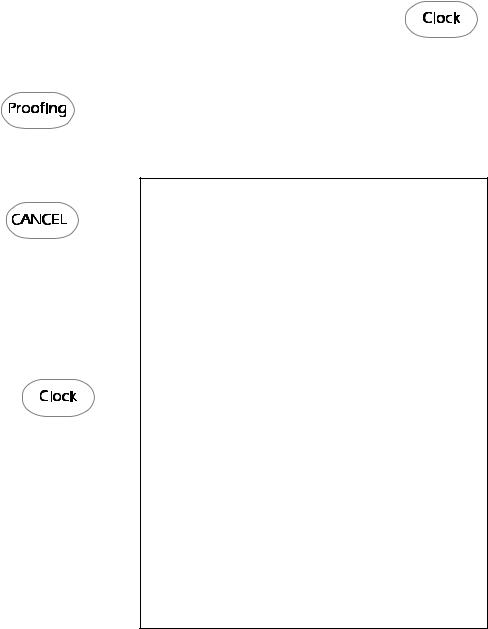
OVEN COOKING
Proofing (select models)
Use the Proofing feature to raise yeast-based bread products before baking. Proofing in the oven protects dough from room temperature changes or drafts that commonly affect proofing done on the countertop.
1. Press the Proofing pad.
•PROOF flashes in the display.
•SET flashes in the display.
2.Press the Autoset 0 pad.
•PROOF will light in the display.
3.When proofing is complete, press the CANCEL pad.
Automatic Shut-Off/Sabbath Mode
The oven will automatically turn off after 12 hours if you accidentally leave it on. This safety feature can be turned off.
To cancel the 12-hour shut-off and run the oven continuously for 72 hours:
1. Press and hold the Clock pad for five seconds
•SAb will be displayed and flash for five seconds.
•SAb will then be displayed continuously until turned off or until the 72-hour time limit is reached.
•BAKE will also be displayed if a bake cycle is in use while the oven is in Sabbath Mode.
•All functions EXCEPT BAKE (Timer, Keep Warm, Clean, etc.) are locked out during the Sabbath Mode.
•A Cook & Hold can be programmed during the Sabbath Mode, however a Delay Cook & Hold is not allowed.
To cancel the Sabbath Mode:
1.Press the CLOCK pad for five seconds.
•SAb will flash for five seconds.
•The time of day will return to the display. OR
2.After 72 hours, the Sabbath Mode will end.
•SAb will flash for five seconds.
•The time of day will return to the display.
Sabbath Mode Notes:
•Sabbath Mode can be turned on at any time with or without the oven on.
•Sabbath Mode cannot be turned on if the touchpads are locked out or when the door is locked.
•Most prompts and messages and all beeps are deactivated when Sabbath Mode is active.
•If the oven is baking when Sabbath Mode is set, BAKE will go out when Bake is canceled. There will be no audible beeps.
•The oven light will not automatically come on when the oven door is opened while the oven is in Sabbath Mode. If the oven light is desired while in Sabbath Mode, it must be turned on before the Sabbath Mode is started.
•When the Sabbath Mode is started, the temperature display will immediately show the set temperature, rather than the actual oven cavity temperature. No preheat beep will sound.
•The self-clean cycle and automatic door lock do not operate during the Sabbath Mode.
•Pressing CANCEL pad will cancel a bake cycle, however the control will stay in the Sabbath Mode.
•If power fails, the oven will power up in Sabbath Mode with 72 hours remaining and no cycle active.
18
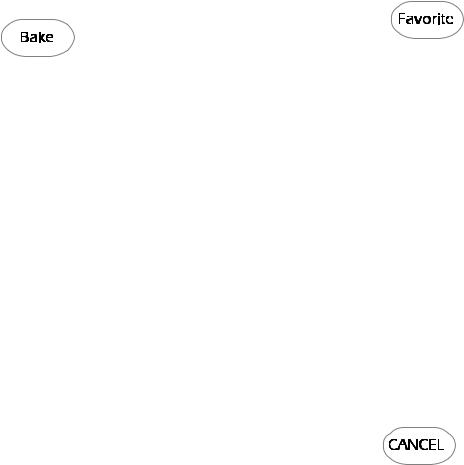
OVEN COOKING
Adjusting the Oven Temperature
Oven temperatures are carefully tested for accuracy at the factory. It is normal to notice some baking or browning differences between a new oven and an old one. As ovens get older, the oven temperature can shift.
You may adjust the oven temperature if you think the oven is not baking or browning correctly. To decide how much to change the temperature, set the temperature 25 degrees higher or lower than your recipe recommends, then bake. The results of the “test” should give you an idea of how much to adjust the temperature.
To adjust the oven temperature:
1.Press the Bake pad.
2.Enter 550° by pressing the appropriate number pads.
3.Press and hold the Bake pad for several seconds or until 00° appears in the display.
If the oven temperature was previously adjusted, the change will be displayed. For example, if the oven temperature was reduced by 15° the display will show “-15°”.
4.Press the Autoset 0 pad to adjust the temperature.
Each time the Autoset pad 0 is pressed, the temperature changes by 5°. The oven temperature can be increased or decreased by 5° to 35°.
Pressing the Autoset 0 pad will first cycle through increasing the oven temperature (5, 10, . . . 35). Continuing to press the Autoset 0 pad will then cycle through decreasing the oven temperature (-35, -30, . . . -5).
5.The time of day will automatically reappear in the display.
You do not need to readjust the oven temperature if there is a power failure or interruption. Temperature adjustment applies to Bake, Convect Bake and Convect Roast (select models) only. Broiling and cleaning temperatures cannot be adjusted.
Changing Temp °F/°C
1.The factory default setting for temperature is Fahrenheit.
2.To change the setting, press and hold the CANCEL and Bake pads at the same time for three seconds.
3.A single beep will sound and the current setting will be displayed (°F or °C). (If no change is made, the range will return to the existing setting after 30 seconds.)
4.To change the setting, press the Autoset 0 pad. Press again to return to existing setting. Wait five seconds and the setting will be complete.
Favorite
The Favorite pad allows you to save the time and temperature from a Cook & Hold function.
To set a Favorite cycle, Cook & Hold must be either active or just programmed.
To set a new Favorite cycle or to save a currently running Cook & Hold as a Favorite:
1.Program a Cook & Hold cycle as described in the Cook & Hold section on page 13.
2. Press and hold the Favorite pad for three seconds.
•The newly set or currently running Cook & Hold cycle will be saved.
•A beep will sound to indicate that the control has accepted the Favorite setting.
To start a cycle programmed into Favorite:
1.Press the Favorite pad.
•Time and temperature for the set Cook & Hold cycle will be displayed. (If no Cook & Hold cycle has been programmed, “nonE” is displayed.)
2.Press the Bake, Convect Bake or Convect Roast (select models) pad.
•The Favorite cycle will begin immediately.
•The selected cycle word will light in the display
•The cooking time will light in the display
When the cooking time has elapsed:
•The selected cycle word will turn off.
•HOLD and WARM will light.
•170° will display.
To cancel a Favorite cycle in progress:
1.Press the CANCEL pad.
•The stored Favorite cycle will not be affected.
2.Remove food from the oven.
19
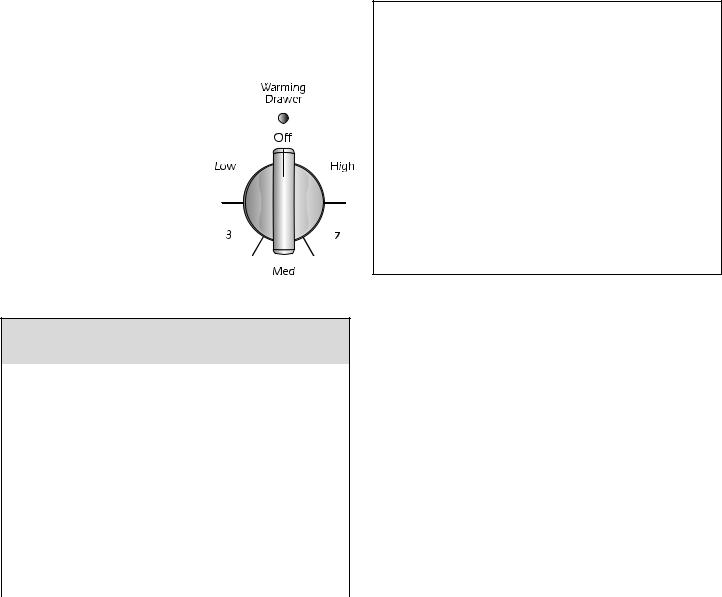
OVEN COOKING
Warming Drawer
The Warming Drawer is used for keeping hot foods at serving temperature. It may also be used for warming breads and pastries.
Operating the Controls:
1. If using the rack, position it where needed.
2. Push in and turn the control knob to the desired setting.
3.Allow the drawer to preheat for ten minutes.
4. Place food in warming drawer.
5. When finished, turn the knob to Off. Remove food from the drawer.
Warming Chart
SUGGESTED SETTINGS
|
Setting |
Type of Food |
|
|
|
|
|
|
|
|
Med - High |
Bacon |
Beef - Rare |
|
|
|
Casseroles |
Cooked Cereals |
|
|
|
Dinner Plate |
Eggs |
|
|
|
Enchiladas |
Fish/Seafood |
|
|
|
Fried Food |
Gravy, Cream Sauces |
|
|
|
Ham |
Hamburger Patties |
|
|
|
Hors d’oeuvres |
Lamb |
|
|
|
Pancakes |
Pizza |
|
|
|
Pork |
Potatoes - Baked |
|
|
|
Potatoes - Mashed |
Poultry |
|
|
|
Vegetables |
Waffles |
|
|
|
|
|
|
|
Low - Med |
Biscuits |
Coffee Cake |
|
|
|
Pies |
Warming - Plates |
|
|
|
|
|
|
Warming Drawer Notes:
•Do not warm food for more than one hour (eggs 30 minutes) after cooking.
•Food must be at serving temperature before being placed in the drawer.
•Breads, pastries and fruit pies may be warmed from room temperature on High setting.
•Use only oven-safe cookware.
•Remove food from plastic bags and place in oven-safe cookware.
•Serving dishes and plates can be warmed while preheating the drawer.
•Cover food with a lid or aluminum foil. Do not use plastic wrap. ( Fried foods do not need to be covered.)
20
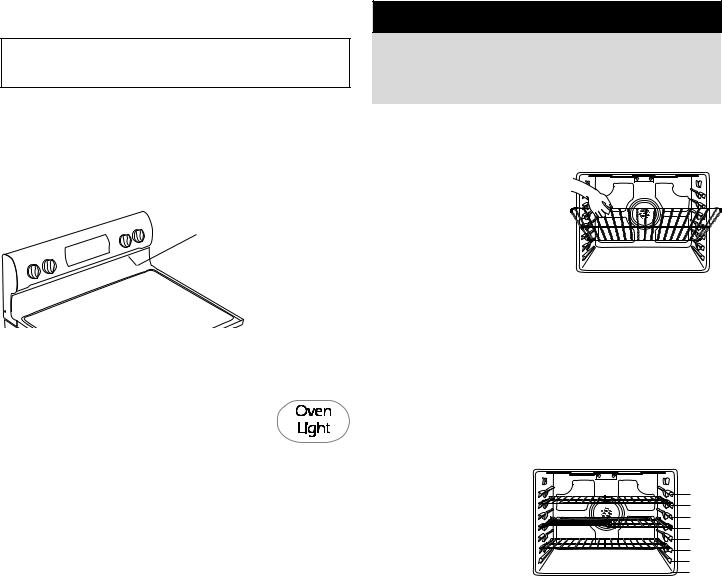
OVEN COOKING
Oven Fan
A convection fan is used to circulate hot air in the oven when the convection feature is selected.
Note: The convection fan will automatically stop when the oven door is opened.
Oven Vent
When the oven is in use the area near the vent may become hot enough to cause burns. Never block the vent opening.
The oven vent is located below the backguard vent shield on your range.
OVEN VENT
LOCATION
Do not place plastics near the vent opening as heat from the vent could distort or melt the plastic.
Oven Light
The oven light automatically comes on when the door is opened. When the door is closed, press the oven light pad to turn the oven light on and off. A beep will sound every time the Oven Light pad is pressed.
Oven Bottom
Protect oven bottom against spillovers, especially acidic or sugary spills, as they may discolor the porcelain enamel. Use the correct pan size to avoid spillovers and boilovers. Do not place utensils or aluminum foil directly on the oven bottom.
Oven Racks
 CAUTION
CAUTION
•Do not attempt to change the rack position when the oven is hot.
•Do not use the oven for storing food or cookware.
The oven has two racks (three if convection). All racks are designed with a lock-stop edge.
To remove:
1. Pull rack straight out until it stops at the lock-stop position.
2. Lift up on the front of the rack and pull out.
To replace:
1.Place rack on the rack support in the oven
2.Tilt the front end up slightly. Slide rack back until it clears the lock-stop position.
3.Lower front and slide back into the oven.
Never cover an entire rack with aluminum foil or place foil on the oven bottom. Baking results will be affected and damage may occur to the oven bottom.
Rack Positions
RACK 7 (highest position): For toasting bread or broiling thin, non-fatty foods.
RACK 6: Used for most broiling.
RACK 5: For multiple rack baking.
7
6
5
4
3
2
1
Oven
Bottom
Three-rack
Convection Baking
(select models)
RACK 4: Used for most
baked goods on a cookie sheet or jelly roll pan, fruit pies, or frozen convenience foods. Also use for broiling chicken pieces.
RACK 3: For casseroles, baking loaves of bread, bundt cakes or custard pies.
RACK 2: Used for roasting small cuts of meat, frozen pies, dessert souffles or angel food cake. Also use for multiple rack baking.
RACK 1: Used for roasting large cuts of meat and poultry.
21
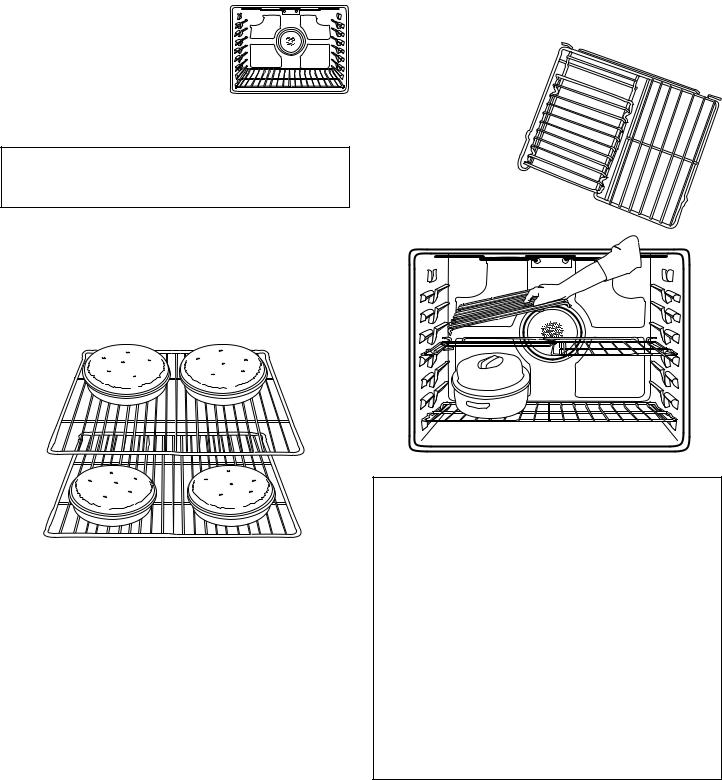
OVEN COOKING
Oven Bottom: Place oven rack on raised sides of oven bottom. Use for additional space when cooking large oven meals.
MULTIPLE RACK COOKING: Two rack: Use rack positions 2 and 5.
Three rack (convection only): Use rack positions 2, 4 and 6 (see illustration).
Note: When Convect baking on two or three racks (select models), check foods at the minimum suggested time to avoid over-browning or over-cooking.
Baking Layer Cakes on Two Racks
For best results when baking cakes on two racks, use racks 2 and 4 for regular baking and racks 2 and 5 for convection baking (select models).
Place the cakes on the rack as shown.
Create-A-SpaceTM Half Rack
Select range models are equipped with a convertible half rack. The left side of the rack can be removed to accommodate a large roaster on the lower
rack. The right side of the rack is still available to hold a casserole dish.
Notes:
•The removable section of the rack can be used as a roasting rack in the broiling pan. Do not use the top insert when using the rack in the broiling pan.
•The removable section of the rack can be used as a cooling rack or trivet.
•Make sure oven is cool before removing or reinstalling the half rack.
•Do not use cookware that extends beyond edge of rack.
•For best results, allow two inches between the pan placed on the rack and the oven side wall.
•Use caution when removing items from the half rack to avoid burns.
•Carefully remove items from the lower rack to avoid disturbing the half rack.
22
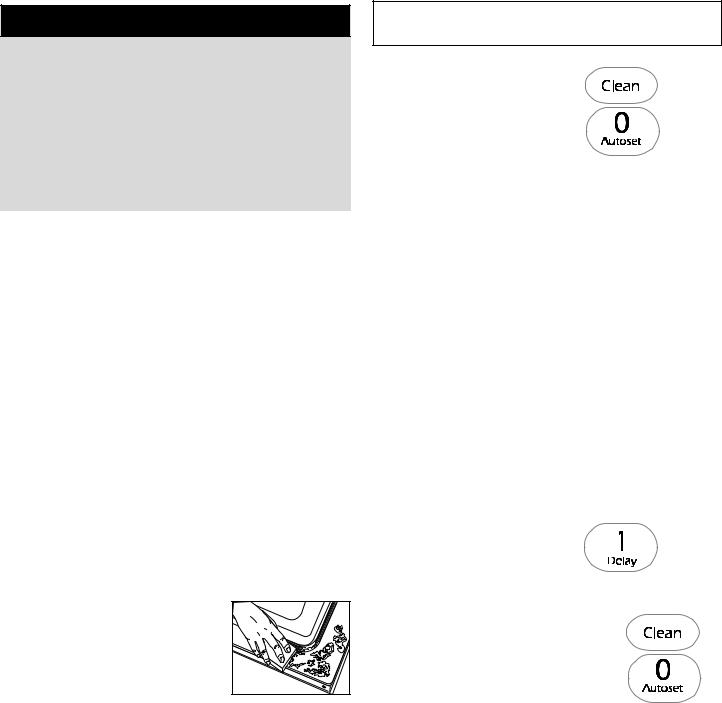
CARE & CLEANING
Self-Clean Oven
 CAUTION
CAUTION
•It is normal for parts of the oven to become hot during a self-clean cycle.
•To prevent damage to oven door, do not attempt to open the door when LOCK is displayed.
•Avoid touching door, window or oven vent area during a clean cycle.
•Do not use commercial oven cleaners on the oven finish or around any part of the oven. They will damage the finish or parts.
The self-clean cycle uses above-normal cooking temperatures to automatically clean the oven interior.
It is normal for flare-ups, smoking, or flaming to occur during cleaning if the oven is heavily soiled. It is better to clean the oven regularly rather than to wait until there is a heavy buildup of soil in the oven.
During the cleaning process, the kitchen should be well ventilated to get rid of normal odors associated with cleaning.
Before Self-Cleaning
1.Turn off the oven light before cleaning. The oven light may burn out during the clean cycle.
2.Remove broiler pan, all pans, and oven racks from the oven. The oven racks will discolor and may not slide easily after a self-clean cycle if they are not removed.
3.Clean oven frame, door frame, area outside of gasket, and around the opening in the door gasket with a nonabrasive cleaner such as Bon Ami* or detergent and water. The self-cleaning process does not clean these areas. They should be cleaned to prevent soil from baking on during the clean cycle. (The gasket is the seal around the oven door and window.)
4. To prevent damage, do not clean or rub the gasket around the oven door. The gasket is designed to seal in heat during the clean cycle.
5.Wipe up excess grease or spillovers from the oven bottom. This
prevents excessive smoking, flare-ups or flaming during the clean cycle.
6.Wipe up sugary and acidic spillovers such as sweet potatoes, tomato, or milk-based sauces. Porcelain enamel is acid-resistant, not acid-proof. The porcelain finish may discolor if acidic or sugary spills are not wiped up before a self-clean cycle.
To set Self-Clean:
Note: Oven temperature must be below 400° F to program a clean cycle.
1. Close the oven door.
2. Press the Clean pad.
•CLEAN flashes.
•SET flashes in the display.
3.Press the Autoset 0 pad.
•MEd (Medium Soil, 3 hours) is displayed.
4.Press the Autoset 0 pad to scroll through the self-cleaning settings.
HVy (Heavy Soil, 4 hours) MEd (Medium soil, 3 hours) LITE ( Light Soil, 2 hours)
Choosing the soil level of the oven automatically programs the self-cleaning time.
5.After four seconds, the oven will start cleaning.
•If the door is not closed, beeps will sound and “door” will display. If the door is not closed within 30 seconds, the self-cleaning operation will be canceled and the display will return to the time of day.
•CLEAN will appear in the display.
•LOCK will flash in the display. Once the door locks, the word will remain steady.
•The cleaning time will start counting down in the display.
To Delay a Self-Clean Cycle:
1.Press the Delay 1 pad.
•DELAY flashes.
•00:00 will flash in the display.
2.Enter the amount of time you want to delay the cycle using the appropriate number pads.
3. Press the Clean pad.
• SET flashes in the display.
4. Press the Autoset 0 pad.
• LITE (Light soil level) is displayed.
* Brand names for cleaning products are registered trademarks of the respective manufacturers.
23
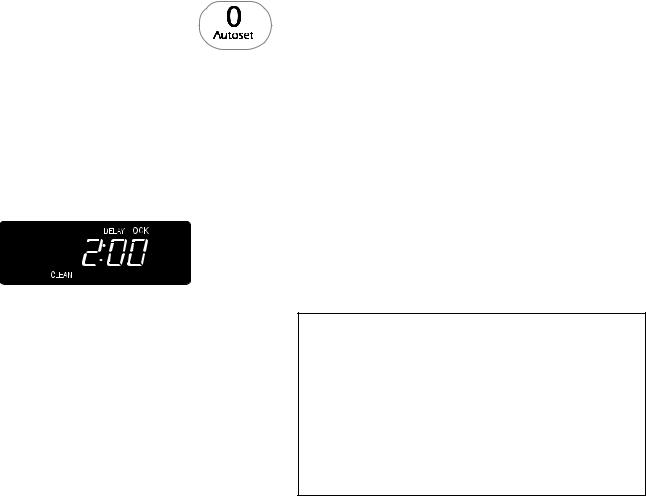
CARE & CLEANING
5.Press the Autoset 0 pad to scroll through the self-cleaning settings.
HVy (Heavy Soil, 4 hours)
MEd (Medium Soil, 3 hours)
LITE (Light Soil, 2 hours)
Choosing the soil level of the oven automatically programs the self-cleaning time.
6.After four seconds, CLEAN and DELAY will light and LOCK will flash in the display. When the oven door latches, LOCK will stop flashing and light continuously to show that the oven is set for a delayed clean operation. The delay time will display.
During the Self-Clean Cycle
When LOCK shows in the display, the door cannot be opened. To prevent damage to the door, do not force the door open when LOCK is displayed.
Smoke and Smells
You may see some smoke and smell an odor the first few times the oven is cleaned. This is normal and will lessen in time.
Smoke may also occur if the oven is heavily soiled or if a broiler pan was left in the oven.
Sounds
As the oven heats, you may hear sounds of metal parts expanding and contracting. This is normal and will not damage the oven.
After Self-Cleaning
About one hour after the end of the self-clean cycle, LOCK will turn off. The door can then be opened.
Some soil may leave a light gray, powdery ash. Remove it with a damp cloth. If soil remains after wiping, that means the clean cycle was not long enough. The soil will be removed during the next clean cycle.
If oven racks were left in the oven and do not slide smoothly after a clean cycle, wipe racks and rack supports with a small amount of vegetable oil to make them easier to move.
Fine lines may appear in the porcelain because it went through heating and cooling. This is normal and will not affect performance.
A white discoloration may appear after cleaning if acidic or sugary foods were not wiped up before the self-clean cycle. This discoloration is normal and will not affect performance.
Notes:
•If the oven door is left open, “door” will flash in the display and a signal will beep until the door is closed and the Clean pad is pressed again.
•If more than five seconds elapse between pressing the Clean pad and the Autoset 0 pad, the program will automatically return to the previous display.
•The oven door will be damaged if the oven door is forced to open when LOCK is still displayed.
24
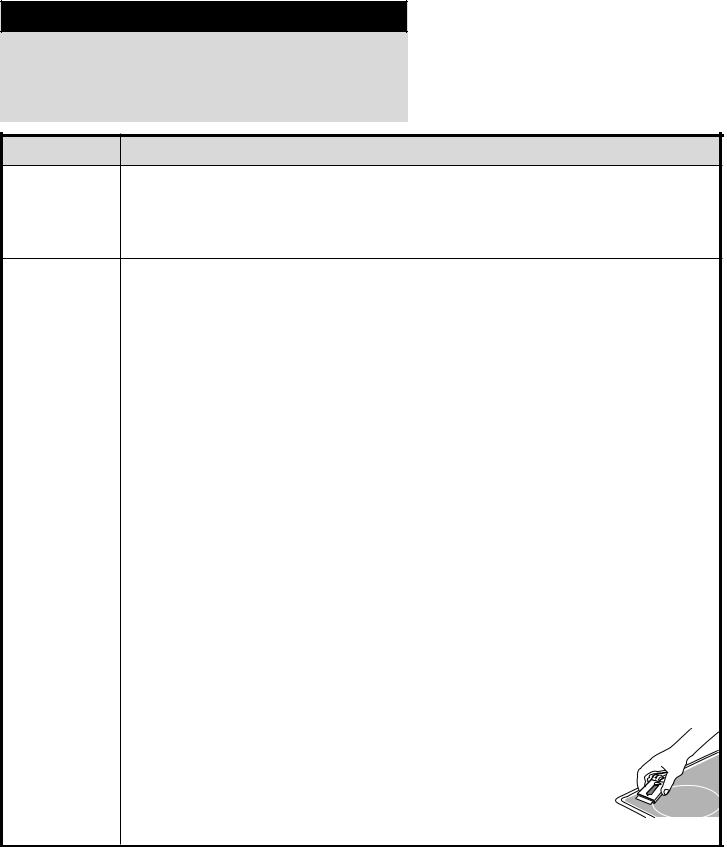
CARE & CLEANING
Cleaning Procedures
 CAUTION
CAUTION
•Be sure appliance is off and all parts are cool before handling or cleaning. This is to avoid damage and possible burns.
•To prevent staining or discoloration, clean appliance after each use.
•If a part is removed, be sure it is correctly replaced.
*Brand names are registered trademarks of the respective manufacturers.
**To order call 1-800-JENNAIR (1-800-536-6247).
PART PROCEDURE
Backguard and Porcelain enamel is glass fused on metal and may crack or chip with misuse. It is acid resistant, not acid Cooktop – proof. All spillovers, especially acidic or sugary spillovers, should be wiped up immediately with a dry cloth. Porcelain Enamel • When cool, wash with soapy water, rinse and dry.
•Never wipe off a warm or hot surface with a damp cloth. This may cause cracking or chipping.
•Never use oven cleaners, abrasive or caustic cleaning agents on exterior finish of range.
Broiler Pan and |
Never cover insert with aluminum foil as this prevents the fat from draining to the pan below. |
|
Insert |
• |
Place soapy cloth over insert and pan; let soak to loosen soil. |
|
• |
Wash in warm soapy water. Use scouring pad to remove stubborn soil. |
|
• |
Broiler pan and insert can be cleaned in dishwasher. |
|
|
|
Clock and |
• |
To activate “Control Lock” for cleaning, see page 10. |
Control Pad |
• |
Wipe with a damp cloth and dry. Do not use abrasive cleaning agents as they may scratch the finish. |
Area |
• |
Glass cleaners may be used if sprayed on a cloth first. DO NOT spray directly on control pad and |
|
|
display area. |
|
|
|
Control Knobs |
• |
Remove knobs in the OFF position by pulling forward. |
|
• |
Wash, rinse and dry. Do not use abrasive cleaning agents as they may scratch the finish. |
|
• |
Turn on each element to be sure the knobs have been correctly replaced. |
|
|
|
Cooktop – |
Never use oven cleaners, chlorine bleach, ammonia or glass cleaners with ammonia. |
|
Glass-Ceramic |
NOTE: Call an authorized servicer if the glass-ceramic top should crack, break or if metal or |
|
|
aluminum foil should melt on the cooktop. |
|
|
• |
Allow the cooktop to cool before cleaning. |
|
• General – Clean cooktop after each use, or when needed, with a damp paper towel and Cooktop Cleaning |
|
|
|
Creme* (Part No. 20000001)**. Then, buff with a clean dry cloth. |
|
NOTE: Permanent stains will develop if soil is allowed to cook on by repeatedly using the cooktop when soiled. |
|
|
• |
Heavy Soils or Metal Marks – Dampen a “scratchless” or “never scratch” scrubber sponge. Apply |
|
|
Cooktop Cleaning Creme* (Part No. 20000001)** and scrub to remove as much soil as possible. Apply a |
|
|
thin layer of the creme over the soil, cover with a damp paper towel and let stand 30 to 45 minutes (2-3 |
|
|
hours for very heavy soil). Keep moist by covering the paper towel with plastic wrap. Scrub again, then |
|
|
buff with a clean dry cloth. |
|
NOTE: Only use a CLEAN, DAMP “scratchless” pad that is safe for non-stick cookware. The pattern and glass |
|
|
will be damaged if the pad is not damp, if the pad is soiled, or if another type of pad is used. |
|
|
• |
Burned-on or Crusty Soils – Scrub with a “scratchless” or “never scratch” scouring pad and |
|
|
Cooktop Cleaning Creme*. |
|
NOTE: Hold a razor blade scraper at 30° angle and scrape any remaining soil. Then, clean as |
|
|
described above. Do not use the razor blade for daily cleaning as it may wear the pattern on |
|
|
the glass. |
|
|
• |
Melted Sugar or Plastic – Immediately turn element to LOW and scrape sugar or |
|
|
plastic from hot surface to a cool area. Then turn element OFF and allow to cool. Clean |
|
|
residue with razor blade scraper and Cooktop Cleaning Creme*. |
25
CARE & CLEANING
PART |
PROCEDURE |
|
Oven Window |
• |
Avoid using excessive amounts of water which may seep under or behind glass causing staining. |
and Door – Glass |
• |
Wash with soap and water. Rinse with clear water and dry. Glass cleaner can be used if sprayed on a cloth |
|
|
first. |
|
• Do not use abrasive materials such as scouring pads, steel wool or powdered cleaners as they will scratch |
|
|
|
glass. |
|
|
|
Oven Interior |
• |
Follow instructions on pages 23-24 to set a self-clean cycle. |
|
|
|
Oven Racks |
• |
Clean with soapy water. |
|
• |
Remove stubborn soil with cleansing powder or soap-filled scouring pad. Rinse and dry. |
|
• Racks will permanently discolor and may not slide smoothly if left in the oven during a self-clean operation. |
|
|
|
If this occurs, wipe the rack edge and rack support with a small amount of vegetable oil to restore ease |
|
|
of movement, then wipe off excess oil. |
|
|
|
Stainless Steel |
• |
DO NOT USE ANY CLEANING PRODUCT CONTAINING CHLORINE BLEACH. |
(select models) |
• DO NOT USE ABRASIVE OR ORANGE CLEANERS. |
|
|
• |
ALWAYS WIPE WITH THE GRAIN WHEN CLEANING. |
|
• Daily Cleaning/Light Soil –– Wipe with one of the following - soapy water, white vinegar/water solution, |
|
|
|
Formula 409 Glass and Surface Cleaner* or a similar glass cleaner - using a sponge or soft cloth. Rinse |
|
|
and dry. To polish and help prevent fingerprints, follow with Stainless Steel Magic Spray (Part No. |
|
|
20000008)**. |
|
• |
Moderate/Heavy Soil –– Wipe with one of the following - Bon Ami, Smart Cleanser, or Soft Scrub* - |
|
|
using a damp sponge or soft cloth. Rinse and dry. Stubborn soils may be removed with a damp multi- |
|
|
purpose Scotch-Brite* pad; rub evenly with the grain. Rinse and dry. To restore luster and remove streaks, |
|
|
follow with Stainless Steel Magic Spray*. |
|
• |
Discoloration –– Using a damp sponge or soft cloth, wipe with Cameo Stainless Steel Cleaner*. Rinse |
|
|
immediately and dry. To remove streaks and restore luster, follow with Stainless Steel Magic Spray*. |
|
|
|
Warming Drawer, |
• |
When cool, wash with warm soapy water, rinse and dry. Never wipe a warm or hot surface with a damp cloth |
Door Handle, Side |
|
as this may damage the surface and may cause a steam burn. |
Panels – Painted |
• |
For stubborn soil, use mildly abrasive cleaning agents such as baking soda paste or Bon Ami.* Do not use |
Enamel |
|
abrasive, caustic or harsh cleaning agents such as steel wool pads or oven cleaners. These products will scratch |
|
|
or permanently damage the surface. |
|
NOTE: Use a dry towel or cloth to wipe up spills, especially acidic or sugary spills. Surface may discolor |
|
|
or dull if soil is not immediately removed. This is especially important for white surfaces. |
|
|
|
|
*Brand names for cleaning products are registered trademarks of the respective manufacturers.
**To order direct, call 1-800-JENNAIR (1-800-536-6247).
26
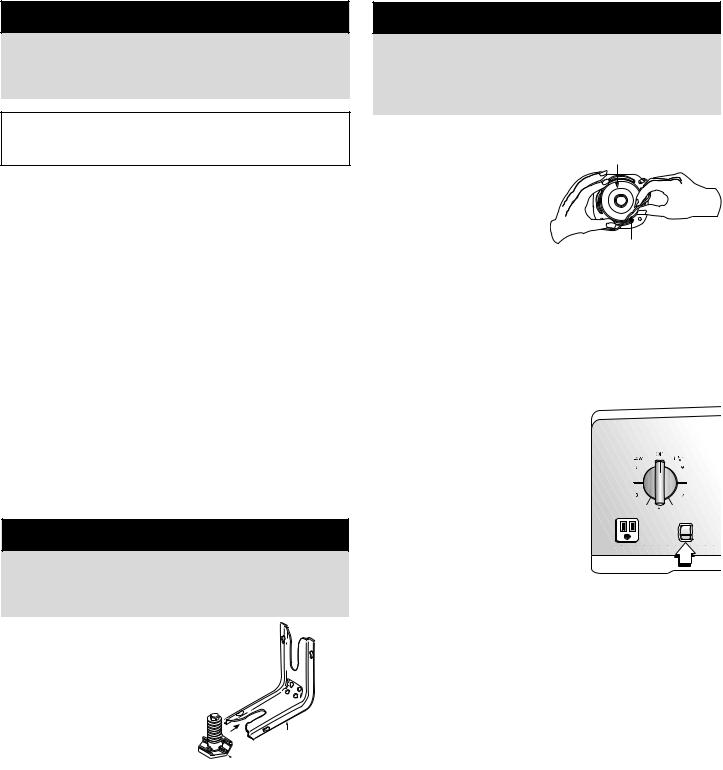
MAINTENANCE
Oven Door
 CAUTION
CAUTION
Do not place excessive weight on or stand on an open oven door. This could cause the range to tip over, break the door, or injure the user.
Note: The oven door on a new range may feel “spongy” when it is closed. This is normal and will decrease with use.
Oven Window
To protect the oven door window:
1.Do not use abrasive cleaning agents such as steel wool scouring pads or powdered cleansers as they may scratch the glass.
2.Do not hit the glass with pots, pans, furniture, toys, or other objects.
3.Do not close the oven door until the oven racks are in place.
Scratching, hitting, jarring or stressing the glass may weaken its structure causing an increased risk of breakage at a later date.
Leveling Legs
 CAUTION
CAUTION
Be sure the anti-tip bracket secures one of the rear leveling legs to the floor. This bracket prevents the range from accidentally tipping.
The range should be leveled when installed. If the range is not level, turn the leveling legs, located at each corner of the range, until range is level.
ANTI- P-TIPBRACKETBRACKET
 LEVELING LEG
LEVELING LEG
LEVELING LEG
Oven Light
 CAUTION
CAUTION
•Disconnect power to range before replacing light bulb.
•Allow oven to cool before replacing light bulb.
•Make sure bulb cover and bulb are cool before touching.
To replace oven light bulb:
1. |
When oven is cool, hold bulb cover |
BULB COVER |
|
||
|
in place, then slide wire retainer |
|
|
off cover. NOTE: Bulb cover |
|
|
will fall if not held in place |
|
|
while removing wire retainer. |
|
2. |
Remove bulb cover and light |
WIRE |
bulb. |
RETAINER |
|
3.Replace with a 40-watt appliance bulb.
4.Replace bulb cover and secure with wire retainer.
5.Reconnect power to range. Reset clock.
Convenience Outlet
(Canadian models only)
The convenience outlet is located on the lower left side of the backguard. Be sure appliance cords do not rest on or near the surface element. If the surface element is turned on, the cord and outlet will be damaged.
The convenience outlet circuit breaker may trip if the small
appliance plugged into it exceeds
10 amps. To reset the circuit
CIRCUIT BREAKER
breaker, press the switch located on the lower edge of the backguard.
27
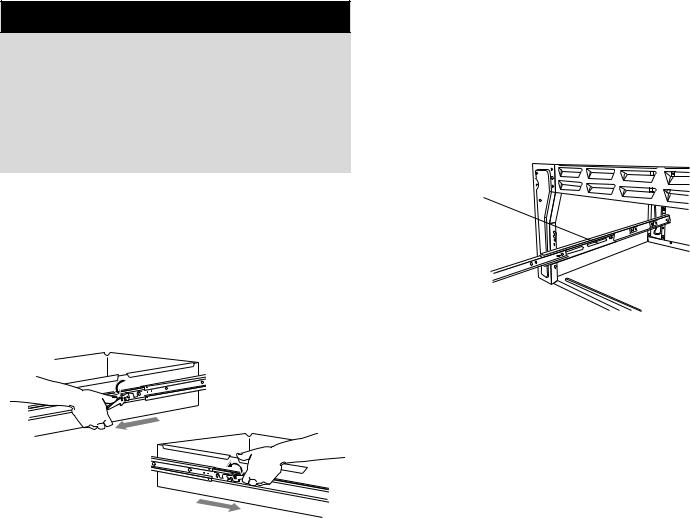
MAINTENANCE
Warming Drawer
 CAUTION
CAUTION
•NEVER store plastic, paper products or flammable materials in this drawer. The drawer may become too warm for these items when the oven is in use or the warming drawer is preheated.
•To avoid contact with the warming drawer heating element, pull drawer all the way out to add or remove food.
•Never use oven cleaners to clean the warming drawer.
To remove warming drawer:
1.Empty drawer and pull out until it is fully open.
2.Locate the black triangle lever on each side of the drawer.
3.Press the lever down on the right side and lift the lever up on the left side at the same time. Then pull drawer out another inch.
4.Carefully pull the drawer all the way out holding on to the sides, not the drawer front.
To replace warming drawer:
1.Pull the bearing glides to the front of the chassis glide. (See picture below.)
2.Align the glide on each side of the drawer with the glide slots on the range.
3.Push the drawer into the range until levers “click” (approximately 2”). Pull the drawer open again to seat bearing glides into position. If you do not hear the levers “click” or the bearing glides do not feel seated, remove the drawer and repeat steps 1 through 3. This will minimize possible damage to the bearing glides.
CHASSIS
GLIDE
BEARING
GLIDE 
28
